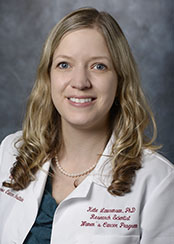Unlocking the Mysteries of Endometriosis
Date
December 3, 2020
Credits

Date
December 3, 2020
Credits
Medical providers featured in this article
In Brief
{{cta-block}}
A comprehensive approach to the problem of diagnosing the agonizing condition
Endometriosis, which affects more than 10% of women, can be agonizing and can increase infertility risk. The condition—which occurs when the uterine lining expands to the ovaries, fallopian tubes and other pelvic tissue—is also frustratingly hard to diagnose.
"We have the rare opportunity for lab investigators generating and analyzing the data to talk to the physicians who are helping manage the disease"

"Some women have symptoms for 15 years but never get an answer," says Kate Lawrenson, PhD, an investigator and associate professor of Obstetrics and Gynecology at Cedars-Sinai. These signs include pain during periods and intercourse as well as gastrointestinal upset. But since these symptoms are not specific to endometriosis, the average time to an accurate diagnosis is eight years.
Lawrenson and her colleagues are looking for biomarkers to try to curtail this delay. They are collecting blood and tissue samples from patients, who also complete a questionnaire about their symptoms. Finding common biomarkers could lead to diagnosing endometriosis with a simple blood test.

Today, the only way to definitively diagnose endometriosis is through surgery and, for many women, an operation is also the best treatment. "But that won’t be appropriate for everyone," says Kelly Wright, MD, a minimally invasive gynecologic surgeon who collaborates with Lawrenson. "Plus we found that 18% of women who undergo surgery for suspected endometriosis don’t actually have the condition."
Lawrenson searches for genetic connections between endometriosis and certain rare subtypes of ovarian cancer. The investigators want to understand what puts some women at higher risk, while the majority of endometriosis patients won’t go on to develop ovarian cancer.
They are also mapping pathways that permit survival of endometriosis cells. "We want to understand how they start in the uterine tissue and become located in the wrong part of the body," Lawrenson says.
Driving the research is a collaboration within the Cedars-Sinai’s Endometriosis Program, allowing researchers, surgeons, a pathologist, a fertility expert, an epidemiologist and other clinicians to work closely toward new insights and therapies.
"We have the rare opportunity for lab investigators generating and analyzing the data to talk to the physicians who are helping manage the disease," Lawrenson says. "It’s really beneficial to be able to brainstorm together."




